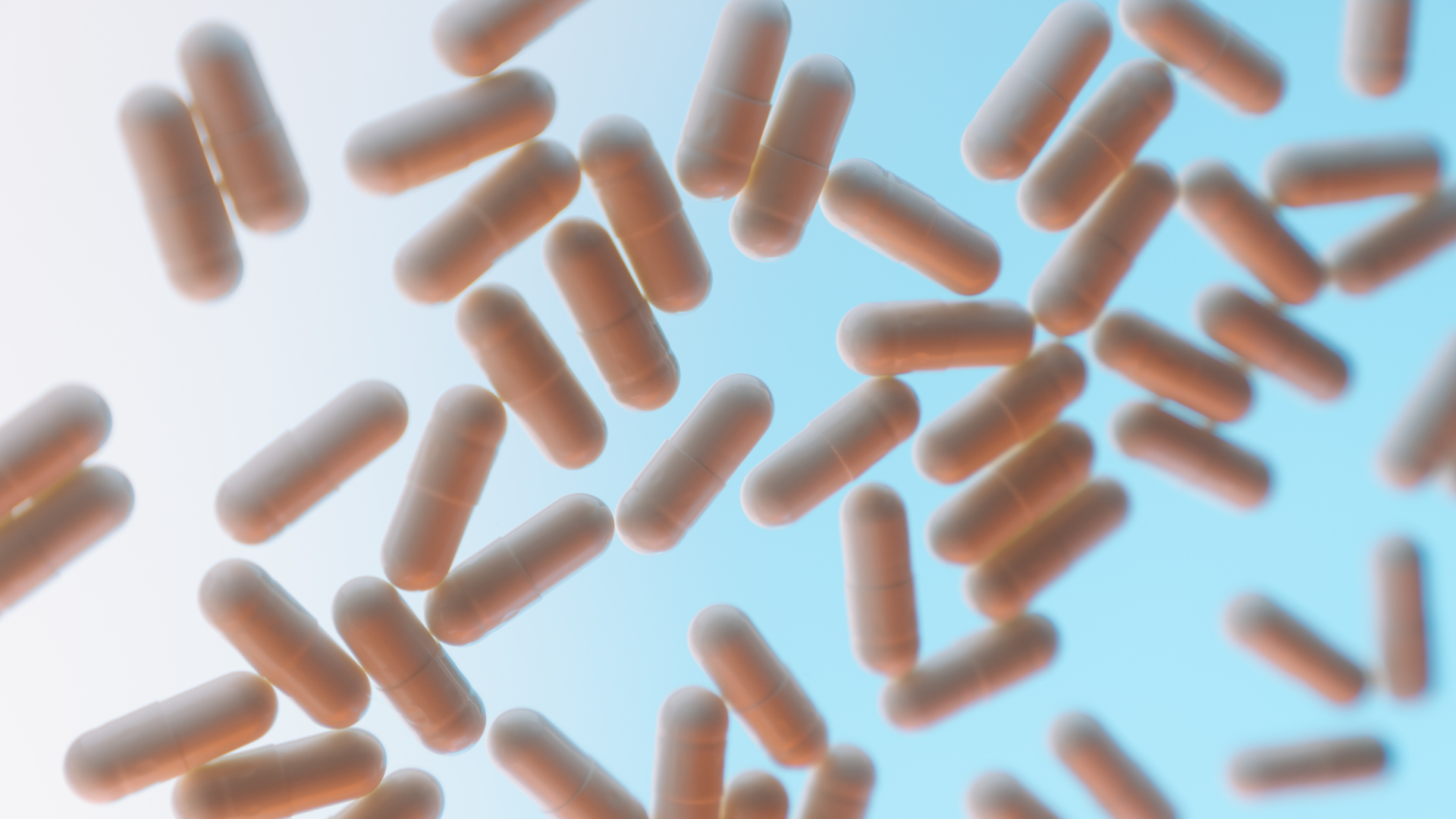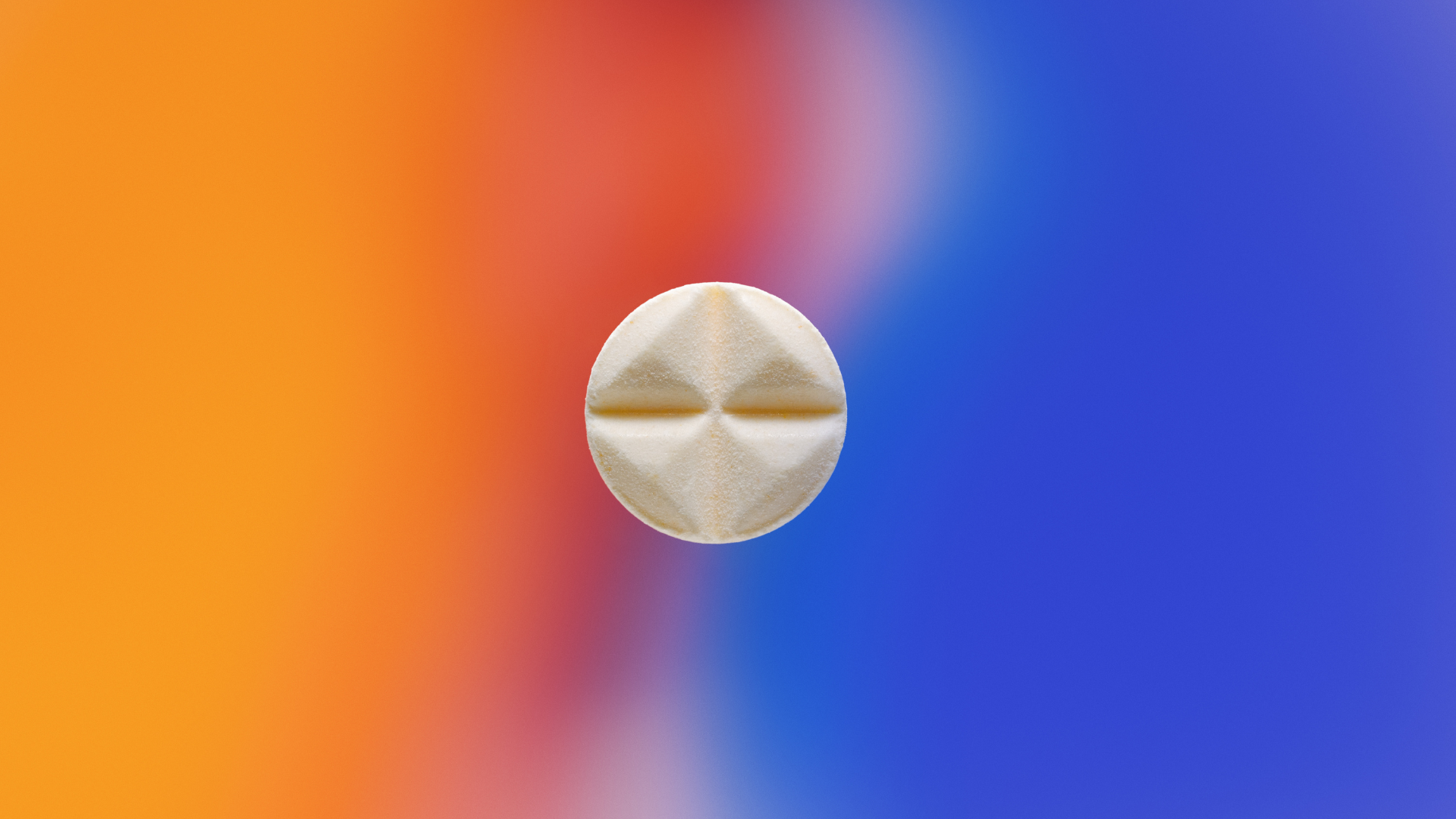Need to Knows
- Progesterone supports menstrual cycles, mood, sleep, and metabolic health, but remains underprescribed.
- Oral micronized progesterone (OMP) helps improve absorption and contributes to GABA-related benefits for sleep and mood.
- Compounded OMP allows customized dosing, allergen-free ingredients, and the use of E4M for steadier release.
- Progesterone capsules may provide reliable systemic effects and endometrial protection.
Introduction: The Overlooked Hormone in Today’s Healthcare Reality
Progesterone is often overlooked in wellness regimens and hormone care, yet it plays a critical role for both women and men in maintaining balance across multiple systems. While estrogen and testosterone tend to get most of the spotlight, progesterone is the quiet force that supports menstrual cycles, mood, sleep, and long-term health. Despite these potential benefits, it remains underrecognized and underutilized in practice.
At Strive, we view progesterone capsules as a vital option for providers. They support equilibrium, offer protection for patients on estrogen therapy, and even have meaningful applications in men’s health as well. Let’s outline how oral micronized progesterone works, how compounded formulations compare to commercial products, and where it can be used in patient care.
What Is Progesterone? A Hormone With Systemic Reach
Progesterone is produced in the ovaries, testes, and adrenal glands. Beyond its reproductive role, it has downstream effects providers can’t ignore:
- Balancing estrogen’s proliferative effects1
- Supporting mood stability2
- Promoting sleep quality3
- Contributing to insulin sensitivity and metabolic function4
- Modulating immune and inflammatory responses5
When progesterone levels drop, providers often see secondary effects—from disrupted cycles and poor sleep to mood changes and metabolic shifts.

Bioidentical Progesterone: Structure, Source, and History
When patients ask about “natural” or “bioidentical” progesterone, they’re referring to a compound that matches the hormone their body already makes.
The method for producing bioidentical progesterone dates back to the 1930s, when researchers learned to convert diosgenin—a plant sterol in yams—into progesterone, identical to the endogenous hormone.6
Several distinctions are essential for accurate patient counseling:
- Diosgenin itself can’t be turned into progesterone through digestion.
- The conversion only happens in the lab through multi-step chemical processing.
- “Yam-based” doesn’t mean extracted directly from yams—it means yams provide the starting raw material.
The outcome: a molecule that is indistinguishable from what the body naturally produces.
Bioidentical Progesterone vs. Progestins: Why the Difference Matters
Providers know the difference, but patients often don’t:
- Bioidentical progesterone binds to progesterone receptors exactly as the endogenous hormone does. It provides endometrial protection7, supports sleep through neuroactive metabolites8, and has a more favorable profile for cardiovascular and breast health compared to many synthetics.9
- Progestins, by contrast, are synthetic analogs of progesterone. They bind to progesterone receptors but also interact with androgen, estrogen, or mineralocorticoid receptors.10 That cross-reactivity explains their differing effects and side-effect profiles—ranging from mood disruption11 to higher clotting12 or breast cancer risks in certain studies.13
In patient discussions, it can be explained this way: progesterone works like the hormone your body naturally makes; progestins are synthetics designed to mimic progesterone effects, but with a different molecular structure, which can affect the way the body responds to them.
Oral Micronized Progesterone: Unlocking Absorption and Clinical Benefits
In its raw form, progesterone is poorly absorbed orally, with <10% bioavailability.14 That’s why micronization—reducing particle size below 10 micrometers—is essential. This process helps improve solubility, bioavailability, and makes oral dosing practical.
The GABA Story: A Unique Advantage
One advantage unique to oral capsules is their first-pass metabolism in the liver. Progesterone converts into allopregnanolone, a neuroactive metabolite that modulates GABA-A receptors. The outcome: improved relaxation, mood stability, and restorative sleep.15
Topical creams and troches bypass this first-pass step, so they don’t provide the similar GABA-mediated benefit.
For providers managing patients with insomnia or anxiety, this is an important distinction—oral capsules aren’t just convenient, they create neuroactive metabolites that other dosage forms might be lacking..
Formulation Insights: Beyond the Active Ingredient
E4M for Controlled Release
Hypromellose USP (Methocel E4M) is a plant-based excipient that forms a gel matrix helping to slow dissolution and support more consistent blood levels.16
- Pharmacies cannot label compounded products as “extended release” under 503A rules, but they can list “contains E4M.”
- Clinically, E4M is particularly valuable for patients who can fall asleep, but wake frequently throughout the night. The gradual release of progesterone offered with E4M, may help reduce nighttime awakenings.
Microcrystalline Cellulose
Another excipient worth noting is microcrystalline cellulose. It is plant-based, hypoallergenic, gluten-free, and vegan-friendly, offering benefits that commercial products may not.
Compounded vs. Commercial Progesterone Capsules
Commercial options (e.g., Prometrium®):
- Limited to 100 mg and 200 mg doses.
- Contains gelatin (not suitable for vegetarians or people with certain religious beliefs), glycerin, lecithin, titanium dioxide, peanut oil (in certain strengths), yellow dye No.10 & red dye No.40
- Mass-produced, with no customization.

Compounded options:
- Flexible dosing beyond standard strengths.
- Allergen-free excipients.
- Ability to add E4M for modified release.
- Available in both 100 mg veggie caps and 200 mg gelatin caps.
Compounding allows providers to adjust dosing, avoid allergens, and accommodate patients with concerns over particular ingredients.
Clinical Applications and Patient Populations
Progesterone capsules are not limited to one population.
Potential Benefits for Women’s Health
- Perimenopause: helps with shortened cycles, mood shifts, and sleep disturbances.17
- Menopause/postmenopause: addresses vasomotor symptoms and provides endometrial protection when paired with estrogen.7
- Fertility and PMS: supports luteal phase and cycle regulation.18
- Postpartum mood concerns: metabolites like allopregnanolone contribute to stabilization.19
- Endometrial protection: prevents estrogen-driven hyperplasia and help reduce cancer risk.20
Biote guidance: Women using Biote may benefit from oral progesterone 225 mg daily.
Potential Benefits for Men’s Health
Progesterone has been called “the forgotten hormone in men,” but it plays measurable roles:
- Modulating estrogen and supporting testosterone biosynthesis.21
- Aids sperm development, activation, and fertilization capacity.22
- Improving mood and sleep through GABA-A metabolites.15
- Inhibiting 5-alpha reductase activity mildly reduces testosterone-to-DHT conversion, which can be beneficial in androgen-driven conditions such as acne or hair loss.23
Biote guidance: In men using testosterone pellets, oral progesterone is recommended to balance the regimen.
Progesterone Unwanted Effects
Oral micronized progesterone is generally well tolerated, but providers should be aware of potential side effects. These may include dizziness, drowsiness, bloating, or breast tenderness. Such effects are typically dose-related and can be improved with adjustment. Taking capsules at night can help minimize daytime drowsiness, and ongoing monitoring ensures patients remain comfortable and adherent.
Capsule vs. Troche vs. Cream: Matching Form to Goal
- Oral capsule: predictable systemic levels, measurable serum progesterone levels, endometrial protection, and GABA-driven benefits.
- Troche: some buccal absorption, but dosing is variable and serum levels are less consistent.
- Cream: topical and convenient, but absorption is inconsistent and inadequate for endometrial protection.
For providers, capsules are often an excellent option when clinical goals demand consistency, reliable progesterone levels, and systemic effects.
Provider Counseling Pearls
- On natural vs. synthetic: “Progesterone is identical to what the body makes; progestins are synthetics with different unwanted effects.”
- On sleep: “Oral progesterone converts into calming neurosteroids that help patients not just fall asleep, but stay asleep.”
- On dosage forms: “Because of how they’re metabolized, capsules may provide systemic effects and endometrial protection that creams and troches usually lack.”
- On customization: “Compounding lets us avoid allergens like gelatin, peanut oil, dyes and allows adjusting doses to patient needs.”

Partnering with Strive for Progesterone Solutions
Compounded progesterone offers providers flexible dosing, allergen-free formulations, and excipient options, such as E4M, that are not available in commercial products.
- For providers: dosing flexibility, peanut-free formulations, E4M options.
- For patients: medications aligned with physiology, tailored to sensitivities and goals.
- For care: a practical way to move beyond one-size-fits-all hormone therapy.
Progesterone might not generate as much buzz as estrogen or testosterone, but its clinical impact is undeniable. By using customized capsules, providers can put this hormone back where it belongs: at the center of balanced, personalized patient care.
Frequently Asked Questions (FAQ)
Q: What is the difference between progesterone and progestins?
A: Progesterone is a bioidentical hormone that is structurally identical to the hormone the body naturally produces. Progestins are synthetic, human -made analogs of progesterone that can have different effects and side-effect profiles due to their interaction with other hormone receptors.
Q: Why is oral progesterone micronized?
A: Oral progesterone is micronized to improve its absorption. In its raw form, it has very poor bioavailability (less than 10%) when taken orally. Micronization—reducing the particle size—is essential to make it soluble and reach its target. .
Q: Can men use progesterone?
A: Yes. Progesterone plays several measurable roles in men's health, including modulating estrogen, supporting testosterone biosynthesis, and improving sleep. It is often used in combination with testosterone replacement therapy to balance hormone levels.
Q: Do progesterone creams and troches provide the same potential benefits as capsules?
A: Not entirely. Oral capsules are unique because they undergo first-pass metabolism in the liver, where they are converted into a neuroactive metabolite called allopregnanolone. This metabolite modulates GABA-A receptors and provides unique benefits for sleep and mood that creams and troches typically lack. Additionally, creams are often not an ideal or reliable delivery method for systemic effects or endometrial protection.
Q: Why should a provider consider compounded progesterone?
A: Compounded progesterone offers greater flexibility than commercial products. It allows for customizable dosing beyond standard strengths, the use of allergen-free excipients (such as avoiding peanut oil), and the ability to add controlled-release agents like E4M to help improve consistency of absorption.
Q: Are progesterone pills and capsules the same thing?
A: Patients often use the term “progesterone pill,” but commercially available options like Prometrium® and compounded alternatives are actually oral capsules. Both terms are used, but “capsule” is more accurate.
References
- Deligdisch L. Effects of hormone therapy on the endometrium. Mod Pathol. 1993;6(1):94-106. PMID: 8426860.
- Stefaniak M, Dmoch-Gajzlerska E, Jankowska K, Rogowski A, Kajdy A, Maksym RB. Progesterone and its metabolites play a beneficial role in affect regulation in the female brain. Pharmaceuticals (Basel). 2023;16(4):520. doi:10.3390/ph16040520. PMID: 37111278; PMCID: PMC10143192.
- Caufriez A, Leproult R, L’Hermite-Balériaux M, Kerkhofs M, Copinschi G. Progesterone prevents sleep disturbances and modulates GH, TSH, and melatonin secretion in postmenopausal women. J Clin Endocrinol Metab. 2011;96(4):E614-23. doi:10.1210/jc.2010-2558. PMID: 21289261.
- Wada T, Hori S, Sugiyama M, et al. Progesterone inhibits glucose uptake by affecting diverse steps of insulin signaling in 3T3-L1 adipocytes. Am J Physiol Endocrinol Metab. 2010;298(4):E881-8. doi:10.1152/ajpendo.00649.2009. PMID: 20071559.
- Raghupathy R, Szekeres-Bartho J. Progesterone: a unique hormone with immunomodulatory roles in pregnancy. Int J Mol Sci. 2022;23(3):1333. doi:10.3390/ijms23031333. PMID: 35163255; PMCID: PMC8835837.
- Ali S, Balachandran K, O’Malley B. Ninety years of progesterone: the “other” ovarian hormone. J Mol Endocrinol. 2020;65(1):E1-E4. doi:10.1530/JME-20-0145. PMID: 32580155; PMCID: PMC7354701.
- Regidor PA. Progesterone in peri- and postmenopause: a review. Geburtshilfe Frauenheilkd. 2014;74(11):995-1002. doi:10.1055/s-0034-1383297. PMID:25484373; PMCID:PMC4245250.
- Lancel M, Faulhaber J, Schiffelholz T, Romeo E, Di Michele F, Holsboer F, Rupprecht R. Allopregnanolone affects sleep in a benzodiazepine-like fashion. J Pharmacol Exp Ther. 1997;282(3):1213-1218. PMID: 9316828.
- Asi N, Mohammed K, Haydour Q, Gionfriddo MR, Vargas OL, Prokop LJ, Faubion SS, Murad MH. Progesterone vs synthetic progestins and the risk of breast cancer: a systematic review and meta-analysis. Syst Rev. 2016;5(1):121. doi:10.1186/s13643-016-0294-5. PMID: 27456847; PMCID: PMC4960754.
- Liu S, Kciuk O, Frank M, Tyson N. Progestins of today and tomorrow. Curr Opin Obstet Gynecol. 2022;34(6):344-350. doi:10.1097/GCO.0000000000000819. PMID: 36036464.
- Bencker C, Gschwandtner L, Nayman S, et al. Progestagens and progesterone receptor modulation: effects on the brain, mood, stress, and cognition in females. Front Neuroendocrinol. 2025;76:101160. doi:10.1016/j.yfrne.2024.101160.
- Skeith L, Bates SM. Estrogen, progestin, and beyond: thrombotic risk and contraceptive choices. Hematology Am Soc Hematol Educ Program. 2024;2024(1):644-651. doi:10.1182/hematology.2024000591. PMID: 39644023; PMCID: PMC11665608.
- Asi N, Mohammed K, Haydour Q, et al. Progesterone vs synthetic progestins and the risk of breast cancer: a systematic review and meta-analysis. Syst Rev. 2016;5(1):121. doi:10.1186/s13643-016-0294-5. PMID: 27456847; PMCID: PMC4960754.
- Maxson WS, Hargrove JT. Bioavailability of oral micronized progesterone. Fertil Steril. 1985;44(5):622-626. PMID: 4054341.
- Kimball A, Dichtel LE, Nyer MB, et al. The allopregnanolone to progesterone ratio across the menstrual cycle and in menopause. Psychoneuroendocrinology. 2020;112:104512. doi:10.1016/j.psyneuen.2019.104512. PMID: 31780185; PMCID: PMC6935417.
- Roy H, Brahma CK, Nandi S, Parida KR. Formulation and design of sustained-release matrix tablets of metformin hydrochloride: influence of hypromellose and polyacrylate polymers. Int J Appl Basic Med Res. 2013;3(1):55-63. doi:10.4103/2229-516X.112242. PMID: 23776841; PMCID: PMC3678683.
- Prior JC. Progesterone for symptomatic perimenopause treatment: progesterone politics, physiology, and potential for perimenopause. Facts Views Vis Obgyn. 2011;3(2):109-120. PMID: 24753856; PMCID: PMC3987489.
- Di Guardo F, Midassi H, Racca A, Tournaye H, De Vos M, Blockeel C. Luteal phase support in IVF: comparison between evidence-based medicine and real-life practices. Front Endocrinol (Lausanne). 2020;11:500. doi:10.3389/fendo.2020.00500. PMID: 33013681; PMCID: PMC7461775.
- Walton N, Maguire J. Allopregnanolone-based treatments for postpartum depression: why/how do they work? Neurobiol Stress. 2019;11:100198. doi:10.1016/j.ynstr.2019.100198. PMID: 31709278; PMCID: PMC6838978.
- Stute P, Neulen J, Wildt L. The impact of micronized progesterone on the endometrium: a systematic review. Climacteric. 2016;19(4):316-328. doi:10.1080/13697137.2016.1187123. PMID: 27277331.
- Oettel M, Mukhopadhyay AK. Progesterone: the forgotten hormone in men? Aging Male. 2004;7(3):236-257. doi:10.1080/13685530400004199. PMID: 15669543.
- Emiliozzi C, Cordonier H, Guérin JF, Ciapa B, Benchaïb M, Fénichel P. Effects of progesterone on human spermatozoa prepared for in vitro fertilization. Int J Androl. 1996;19(1):39-47. doi:10.1111/j.1365-2605.1996.tb00433.x. PMID: 8698537.
- Cassidenti DL, Paulson RJ, Serafini P, Stanczyk FZ, Lobo RA. Effects of sex steroids on skin 5α-reductase activity in vitro. Obstet Gynecol. 1991;78(1):103-107. PMID: 1828548.
The information provided in this article is for informational and educational purposes only. Refer to the cited references for more information regarding the content presented. The creators of this content disclaim any liability for decisions made based on the information presented. The information provided relates to patient-specific compounding. Compounded medications are specially prepared for individual patient needs and, as such, have not been reviewed or approved by the U.S. Food and Drug Administration (FDA). Prescribers should use their independent clinical judgment when determining appropriateness for individual patients.
















